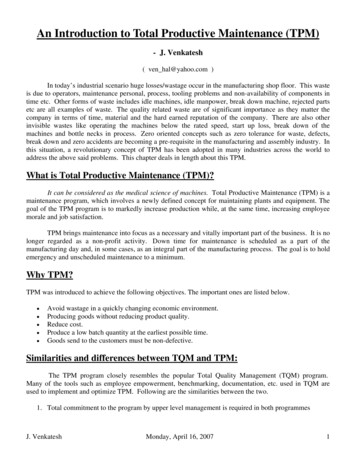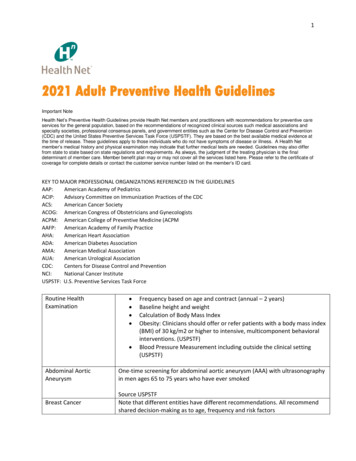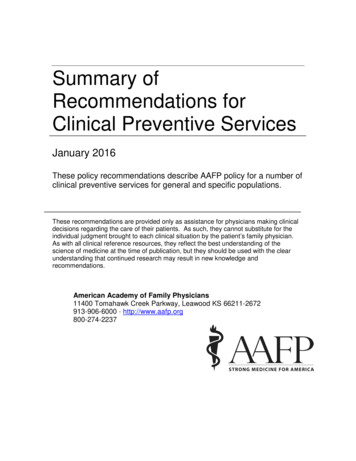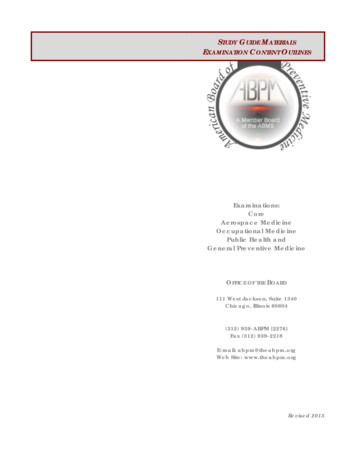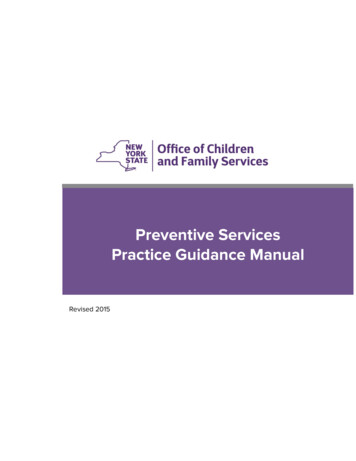
Transcription
Förderreuther et al. The Journal of Headache and ) 19:121RESEARCH ARTICLEThe Journal of Headacheand PainOpen AccessPreventive effects of galcanezumab in adultpatients with episodic or chronic migraineare persistent: data from the phase 3,randomized, double-blind, placebocontrolled EVOLVE-1, EVOLVE-2, andREGAIN studiesStefanie Förderreuther1, Qi Zhang2, Virginia L. Stauffer3*, Sheena K. Aurora3 and Miguel J. A. Láinez4AbstractBackground: Maintenance of effect following treatment with galcanezumab compared to placebo in adult patients withepisodic or chronic migraine was evaluated.Methods: In 2 similarly designed studies of patients with episodic migraine (6 months) and 1 study of patients withchronic migraine (3 months), patients randomized in a 1:1:2 ratio received a subcutaneous injection of galcanezumab120 mg/month (after an initial loading dose of 240 mg) or 240 mg/month or placebo. Maintenance of effect during thedouble-blind phase was evaluated based on a comparison of the percentages of galcanezumab- and placebo-treatedpatients with maintenance of 30, 50, 75, and 100% response (defined as 30, 50, 75, and 100% reduction frombaseline in monthly migraine headache days [MHD]) at an individual patient level. Logistic regression analyses wereused for between treatment comparisons.Results: A total of 1773 adult patients with episodic migraine (n 444 for galcanezumab 120 mg; n 435 for galcanezumab240 mg; n 894 for placebo for 2 studies pooled) and 1113 patients with chronic migraine (n 278 for galcanezumab 120mg; n 277 for galcanezumab 240 mg; n 558 for placebo) were evaluated. In patients with episodic migraine, 50%response was maintained in 41.5 and 41.1% of galcanezumab-treated patients (120 mg and 240 mg, respectively) for 3consecutive months (until patient’s endpoint) and 19.0 and 20.5%, respectively, for 6 consecutive months and was significantlygreater than the 21.4 and 8.0% of placebo-treated patients at 3 and 6 months consecutively (P 0.001). Approximately 6% ofgalcanezumab-treated patients maintained 75% response all 6 months versus 2% of placebo-treated patients. Fewgalcanezumab-treated patients maintained 100% response. In patients with chronic migraine, 29% of galcanezumab-treatedpatients maintained 30% response all 3 months compared to 16% of placebo patients while 50% response wasmaintained in 16.8 and 14.6% of galcanezumab-treated patients (120 mg and 240 mg) and was greater than placebo (6.3%;p 0.001). Few patients maintained 75% response.Conclusions: Treatment with galcanezumab 120 mg or 240 mg demonstrated statistically significant and clinicallymeaningful persistence of effect in patients with episodic migraine ( 3 and 6 consecutive months) and in patients withchronic migraine (for 3 months).(Continued on next page)* Correspondence: vstauffer@lilly.com3Eli Lilly and Company, Lilly Corporate Center, Indianapolis, IN 46285, USAFull list of author information is available at the end of the article The Author(s). 2018 Open Access This article is distributed under the terms of the Creative Commons Attribution 4.0International License (http://creativecommons.org/licenses/by/4.0/), which permits unrestricted use, distribution, andreproduction in any medium, provided you give appropriate credit to the original author(s) and the source, provide a link tothe Creative Commons license, and indicate if changes were made.
Förderreuther et al. The Journal of Headache and Pain(2018) 19:121Page 2 of 9(Continued from previous page)Study identification and trial registration: Study Identification: EVOLVE-1 (I5Q-MC-CGAG); EVOLVE-2 (I5Q-MC-CGAH);REGAIN (I5Q-MC-CGAI)Trial Registration: ClinicalTrials.gov; NCT02614183 (EVOLVE-1); NCT02614196 (EVOLVE-2); NCT02614261 (REGAIN)Keywords: Galcanezumab, Migraine, Preventive, Persistence, MaintenanceBackgroundGalcanezumab is a humanized monoclonal antibody, indicated for the prevention of migraine, that binds to calcitonin gene-related peptide (CGRP) and prevents itsbiological activity without blocking the CGRP receptor [1].The efficacy of galcanezumab was examined in 3 randomized, double-blind, placebo-controlled, Phase 3 studies ofgalcanezumab (120 and 240 mg/month) in patients withepisodic (EVOLVE-1 and EVOLVE-2 6-month studies) orchronic (REGAIN 3-month study) migraine [2–4]. Themean monthly percentages of galcanezumab-treatedpatients with episodic migraine or chronic migraine thatachieved 50% reduction in MHD was greater than the percentages of placebo-treated patients (60% versus 36% to 39%and 27% versus 15%, respectively) [2–4]. For patients withepisodic migraine, galcanezumab-treated patients experienced approximately 4 fewer MHD/month (versus 2 withplacebo) and patients with chronic migraine had approximately 5 fewer MHD/month (versus 3 with placebo) with asimilar effect in both galcanezumab dose groups [2–4].Data on current treatments for migraine preventionsupport that patients on recently approved and oldertreatments for migraine prevention do achieve a 50%level of response [5–7]. However, the important questionof whether a 50% reduction in monthly MHD is maintained over time has not been sufficiently addressed forboth episodic and chronic migraine [5, 8–10]. Further,can the additional responses of 30, 75, and 100%reduction in monthly MHD, also recognized to be clinically meaningful, be maintained [11–13]? For patients ona preventive treatment, this is a particularly importantaspect since patients seek a medication with a consistentefficacy profile over time. Clinically, tachyphylaxis hasbeen reported frequently by patients and physicians.The current study evaluated data from the placebocontrolled EVOLVE-1 and EVOLVE-2 episodicmigraine trials and the REGAIN chronic migrainetrial and compared galcanezumab treatment to placebo in the maintenance of 30% (chronic only), 50, 75, and 100% (episodic only) response in the reduction of MHD from baseline.MethodsStudy designDetailed descriptions of the study design for the 2episodic migraine (6-month) and 1 chronic migraine(3-month) double-blind studies, have been reported separately (ClinicalTrials.gov NCT02614183, NCT02614196,and NCT02614261) [2–4]. Briefly, adult patients were randomized 1:1:2 and received subcutaneous injections ofgalcanezumab 120 mg/month (after a 240 mg initial loading dose) or 240 mg/month or placebo. Episodic migrainewas defined as having between 4 and 14 MHD and at least2 migraine attacks per month [2, 3, 14]. Chronic migrainewas defined as having headache 15 days per month for 3 months and having features of migraine headache 8days per month [4, 14]. The continuation or start of anyadditional migraine preventive treatments was not permitted; the exception for patients with chronic migraine wasthe use of topiramate or propranolol provided theyentered trial on a stable dose. The 50, 75, and 100%response rates during the 6-month (episodic) or 3-month(chronic) study periods were key secondary objectives(adjusted for multiple testing) and response rates at eachmonth (episodic and chronic studies) were secondaryoutcomes (not adjusted for multiple testing). The studyprotocols were reviewed and approved by the appropriateinstitutional review board for each of the study sites. Thestudies were conducted according to Good Clinical Practiceand the Declaration of Helsinki guidelines. Patients provided written informed consent before undergoing studyprocedures. The trials are registered with ClinicalTrials.gov(NCT02614183, NCT02614196, and NCT02614261).Statistical methodData from the 2 episodic migraine trials combined and 1chronic migraine trial were included in the analysis. Inthese trials, a 30, 50, 75, and 100% response rate at eachmonth was defined as the percentage of patients meetinga defined threshold ( 30, 50, 75, and 100%) in thereduction of the number of monthly MHD during thedouble-blind treatment period. Only patients with botha baseline and 1 month of non-missing post-baselineMHD values were included in the analysis. The evaluation of maintenance of effect during the double-blindtreatment period was a comparison of the percentagesof galcanezumab- and placebo-treated patients withmaintenance of 30, 50, 75, and 100% response at theindividual patient level. In the episodic studies, maintenance of response was calculated for those with at least 3months (until patient’s endpoint) and 6 consecutivemonths and 3 consecutive months for chronic migraine. A
Förderreuther et al. The Journal of Headache and Pain(2018) 19:121logistic regression analysis was used for between-treatmentgroup comparisons. At each month, a cumulative 50%maintenance of response was also calculated and defined aspatients with 50% response at a specific month (or before)and all subsequent months. For repeated binary data ofmonthly 50% response and cumulative 50% sustainedresponse, a categorical, pseudolikelihood-based repeatedmeasures model was implemented with SAS PROC GLIMMIX [15]. Two-sided p-values were calculated and compared with significance level of 0.05.ResultsPatient dispositionData from the episodic migraine trials were from1773 adult patients with episodic migraine treatedwith 120 mg galcanezumab (n 444), 240 mg galcanezumab (n 435), or placebo (n 894). Data from thechronic migraine trial were from 1113 patients withchronic migraine treated with 120 mg galcanezumab(n 278), 240 mg galcanezumab (n 277), or placebo(n 558). Baseline demographics and disease characteristics of the episodic and chronic migraine populationsshow that over 80% were female, over 74% were white,had a mean age of 40 years, and had migraine disease duration of 20 years. As permitted by protocol for the chronicmigraine trial, concomitant use of topiramate or propranolol during the double-blind phase, across all treatmentgroups, occurred in 10.3 and 3.6% of patients, respectively.At baseline, the mean MHD/month was 9.1 for episodicmigraine and 19.3 for chronic migraine. The mean baseline Migraine Disability Assessment score for patientstreated with galcanezumab or placebo was 33.1 forepisodic migraine and 65.8 (galcanezumab) and 68.7(placebo) for chronic migraine and was reflective of severe(episodic) and very severe (chronic) migraine disability.The mean baseline Migraine-Specific Quality of LifeQuestionnaire Role Function-Restrictive subdomain scorefor patients treated with galcanezumab or placebo withepisodic migraine was 51.1 and 52.1, respectively, and withchronic migraine was 39.1 and 38.4, respectively. Patientswith chronic migraine had greater functional impairmentthan patients with episodic migraine (Table 1).Proportions of patients with 50% responseThe model-estimated proportions of patients withepisodic migraine achieving 50% response were significantly greater for both galcanezumab dose groups compared to placebo starting at Month 1 (p 0.001) and ateach month after (p 0.001), as well as overall across 6months (p 0.001) (Table 2). For patients with chronicmigraine, the model-estimated proportions of patientsachieving 50% response was significantly greater forboth dose groups compared to placebo starting atMonth 1 (p 0.001) and at each month after (p 0.004),Page 3 of 9as well as overall across 3 months (p 0.001) (Table 2).The absolute values for the proportions of patients withepisodic or chronic migraine that achieved 50%response were very similar to the estimated values proportions and are shown in Additional file 1: Table S1.Maintenance of responseSignificantly more patients with episodic migrainetreated with galcanezumab in both dose groups(approximately 41%) maintained response of 50%fewer MHD for 3 consecutive months until patient’sendpoint compared to placebo (21%). Over Month 1to Month 6, approximately 20% of galcanezumabtreated patients in both dose groups maintained aresponse of 50% fewer MHD that was significantlygreater than placebo (8%) (Fig. 1).In patients with chronic migraine, significantly morepatients in both the 120 mg (17%) and 240 mg (15%)galcanezumab dose groups maintained a response of 50% fewer MHD for 3 consecutive months compared to placebo (6%) (Fig. 2). The difference betweendose groups for either episodic or chronic migraine inthe proportions of patients with maintenance ofresponse was not significant.The model-estimated proportions of patients withepisodic migraine who maintained a response of 75and 100% and those patients with chronic migrainewho maintained a response of 30 and 75% areshown in (Table 3). The proportions of galcanezumabtreated patients with episodic migraine who maintaineda response of 75% fewer MHD for 3 consecutivemonths until patient’s endpoint (19.7 and 21.3%) wassignificantly greater than placebo (8.5%; p 0.001).While fewer, 6% of galcanezumab-treated patientsmaintained a response of 75% fewer MHD for all 6months compared with 1.8% of placebo-treatedpatients. A small percentage of patients maintained100% response for 3 consecutive months and very fewmaintained 100% response for all 6 months. The proportions of galcanezumab-treated patients with chronicmigraine who maintained a response of 30% fewerMHD for all 3 months (29%) was significantly greaterthan placebo (16.4%; p 0.001). The proportions ofpatients who maintained 75% fewer MHD for all 3months was not different between the galcanezumaband placebo groups.Characterization of patients with episodic migraine with 50% response at month 1Among the 50.9 and 47.2% of galcanezumab 120 mg- and240 mg-treated patients with episodic migraine who met 50% response at Month 1, the average reduction in MHDover the remaining 5 months of the double-blind phase was66.6 and 71.5%. Of the 23.8% of placebo-treated patients
Förderreuther et al. The Journal of Headache and Pain(2018) 19:121Page 4 of 9Table 1 Patient demographics and disease characteristics of galcanezumab -treated patients from episodic and chronic migraine trialsVariablesEpisodic Migraine StudiesaaAge, years, mean (SD)Chronic Migraine StudybGalanezumabN 879PlaceboN 894GalcanezumabbN 555PlaceboN 55840.7 (11.4)41.9 (11.4)40.4 (12.2)41.6 (12.1)Female, n (%)744 (84.6)755 (84.5)463 (83.4)483 (86.6)Race white, n (%)652 (74.2)681 (76.2)447 (80.7)432 (77.4)Ethnicity not Hispanic or Latinoc, n (%)664 (78.4)677 (79.4)387 (74.0)401 (76.7)Geographic region, n (%)North America647 (73.6)657 (73.5)320 (57.7)321 (57.5)Europe119 (13.5)122 (13.7)138 (24.9)140 (25.1)Other113 (12.9)115 (12.9)97 (17.5)97 (17.4)Body mass index, kg/m2 mean (SD)27.6 (5.5)27.6 (5.5)26.5 (5.4)26.9 (5.6)Migraine disease duration, years, mean (SD)20.1 (12.2)20.5 (12.5)20.2 (12.7)21.9 (12.9)Migraine headache days/month, mean (SD)9.1 (2.9)9.1 (3.0)19.3 (4.4)19.6 (4.6)MHD/month with acute medication use, mean (SD)7.4 (3.4)7.5 (3.4)14.8 (6.3)15.5 (6.6)Headache days/month, mean (SD)10.7 (3.7)10.6 (3.4)21.3 (4.0)21.5 (4.1)Migraine with aura, n (%)467 (53.1)471 (52.7)294 (53.0)310 (55.6)Prior preventive treatment in past 5 years, n (%)559 (63.6)555 (62.1)431 (77.7)435 (78.0)Failed 2 preventives in past 5 years, n (%)88 (10.0)85 (9.5)165 (29.7)163 (29.2)MIDAS total, mean (SD)33.1 (28.2)33.1 (29.3)65.8 (57.3)68.7 (57.4)MSQ RF-R, mean (SD)51.1 (16.1)52.1 (15.6)39.1 (17.3)38.4 (17.2)PGI-S, mean (SD)4.3 (1.2)4.3 (1.2)4.8 (1.3)4.9 (1.2)Abbreviations: MHD migraine headache days, MIDAS Migraine Disability Assessment, MSQ Migraine-Specific Quality of Life Questionnaire version 2.1, PGI-S PatientGlobal Impression of Severity, RF-R Role Function-Restrictive, SD standard deviationaPooled data from two parallel 6-month trials in patients with episodic migraineb3-month trialcNot all patients reported ethnicity datawith 50% response at Month 1, the average reduction inMHD was 63.2%. Further, among only those with 50%response at Month 1, 85.4 and 92.4% of patients in the 2galcanezumab dose groups and 80.7% in the placebo groupaveraged at least a 40% response over the remaining 5months. Moreover, 80.8 and 85.4% of patients in the 2 galcanezumab groups respectively and 71.1% of patients in theplacebo group averaged at least 50% response over theremaining 5 months.Cumulative and onset of maintenance of responseThe cumulative maintenance of response is defined asindividual patients who met 50% response starting at agiven month (or before) and then all the months subsequent. The proportions of patients with episodicmigraine in the galcanezumab 120 mg and 240 mggroups achieving cumulative maintenance of 50%response was superior to placebo at every month of the6-month double-blind phase (p 0.001) (Fig. 3). Forexample, 31% of patients with episodic migraine treatedwith galcanezumab 120 mg reached 50% at or beforeMonth 3 and maintained that response in the subsequent months (Month 4 to Month 6). The differencebetween the galcanezumab dose groups for cumulativemaintenance of response was not significant.The onset of 50% maintenance of response andthe percentage of patients with episodic or chronicmigraine who reached 50% response at the specificmonth (but not before) and then maintained thatresponse in the subsequent months of treatment isshown in Table 4. To illustrate the onset for patientswith episodic migraine, 19, 6, and 6% of patientstreated with galcanezumab 120 mg reached 50% response at Months 1, 2, and 3, respectively, and maintained that response in the subsequent months oftreatment (Months 2 to 6, Months 3 to 6, and Month4 to 6, respectively). Across the 6-month double-blindphase, onset of maintenance of response occurred forapproximately 4 to 21% of galcanezumab-treated patients with highest rate occurring in Month 1. In allbut one time point, the proportions of patients weregreater in the galcanezumab treatment groups thanthe placebo group at each month. The exception wasat 6 months where the proportions of patients weresimilar between the galcanezumab 120 mg (10.6%)and placebo (10.9%) groups.
Förderreuther et al. The Journal of Headache and Pain(2018) 19:121Page 5 of 9Table 2 Model-estimated proportion of patients with episodic and chronic migraine with 50% responseResponse rateGalcanezumab 120 mg(N 436)Galcanezumab 240 mg(N 428)Placebo(N 875)37.2%Episodic migraineOverall 6 monthsOdds ratio (95% CI)Month 1, %Odds ratio (95% CI)Month 6, %Odds ratio (95% CI)Chronic migraineOverall 3 monthsOdds ratio (95% CI)Month 1, %Odds ratio (95% CI)Month 3, %Odds ratio (95% CI)60.8%58.7%2.6 (2.2, 3.1)*2.4 (2.0, 2.8)*50.9%47.2%3.3 (2.6, 4.2)*2.9 (2.2, 3.7)*65.7%63.2%2.4 (1.9, 3.1)*2.2 (1.7, 2.8)*Galcanezumab 120 mg(N 273)Galcanezumab 240 mg(N 274)Placebo(N 538)15.4%27.6%27.5%2.1 (1.6, 2.8)*2.1 (1.6, 2.8)*23.7%21.2%2.8 (1.9, 4.2)*2.5 (1.7, 3.6)*31.9%34.0%1.6 (1.2, 2.3)†1.8 (1.3, 2.5)*23.8%44.3%9.9%22.4%Abbreviations: CI confidence interval*p 0.001 versus placebo†p 0.004 versus placeboIn patients with chronic migraine, the proportions ofpatients treated with galcanezumab 120 mg or 240 mgachieving cumulative maintenance of 50% responsewas superior to placebo at every month of the 3-monthdouble-blind phase (p 0.001). At Month 3 or before,approximately 30% of patients in the galcanezumabtreatment groups achieved and maintained 50%response (Fig. 4). The difference between the galcanezumab dose groups for cumulative maintenance ofresponse was not significant. To illustrate the onset ofthe maintenance of 50% response for patients withchronic migraine (Table 4), 15, 5, and 11% of patientstreated with galcanezumab 120 mg reached 50%response at Month 1, 2, and 3, respectively.Safety and tolerabilityThe most commonly reported treatment-emergent adverse events (TEAE) were injection site-related pain,reaction, erythema, pruritus, and swelling. Discontinuation due to an injection site-related TEAE was low( 0.5% across all 3 trials). There were no significantdifferences between galcanezumab and placebo inchanges in vital signs and blood pressure. The safetyFig. 1 Episodic migraine: proportions of patients with maintenance of 50% response for 3 consecutive months until patient’s endpoint andresponse from month 1 to month 6. a maintenance of 50% response for 3 consecutive months. b maintenance of 50% response frommonth 1 to month 6. Abbreviations: OR odds ratio. *** p 0.001
Förderreuther et al. The Journal of Headache and Pain(2018) 19:121Page 6 of 9Fig. 2 Chronic migraine: proportions of patients with maintenance of 50% response for 3 consecutive months. Abbreviations: OR oddsratio. *** p 0.001profile between the 120 mg and 240 mg doses weresimilar [2–4].DiscussionTreatment with galcanezumab 120 mg or 240 mg demonstrated statistically significant and clinically meaningful maintenance of effect in patients with episodicmigraine ( 3 consecutive months until patient’sendpoint and 6 consecutive months) or chronic migraine(3 months). Starting at Month 1, about 20% ofgalcanezumab-treated patients (either dose group) withepisodic migraine had a sustained response of 50%reduction of MHD over 6 months; about 41% of patientsmaintained 50% response over 3 months. Among onlyTable 3 Model-estimated proportion of patients with episodic and chronic migraine with maintained responseResponse rateGalcanezumab 120 mg(N 436)Galcanezumab 240 mg(N 428)Placebo(N 875)19.7%21.3%8.5%Episodic migrainea75% Response 3 consecutive monthsbOdds ratio (95% CI)75% Response all 6 monthsOdds ratio (95% CI)100% Response 3 consecutive monthsbOdds ratio (95% CI)100% Response all 6 monthsOdds ratio (95% CI)Chronic migrainec30% Response all 3 monthsOdds ratio (95% CI)75% Response all 3 monthsOdds ratio (95% CI)**2.7 (1.9, 3.7)2.9 (2.1, 4.1)6.2%6.8%*1.8%*3.5 (1.9, 6.3)3.9 (2.1, 6.9)3.7%6.5%2.7%*1.4 (0.7, 2.5)2.5 (1.4, 4.2)0.7%1.4%0.2%†2.9 (0.8, 10.4)5.3 (1.6, 17.1)Galcanezumab 120 mg(N 273)Galcanezumab 240 mg(N 274)Placebo(N 538)29.3%29.2%16.4%2.1 (1.5, 3.0)*2.1 (1.5, 3.1)*2.6%2.9%1.3 (0.6, 3.1)1.5 (0.6, 3.4)Abbreviations: CI confidence intervala6-month studybMaintained response until patient’s endpoint of the 6-month, double-blind periodc3-month study*p 0.001 versus placebo†p 0.006 versus placebo2.0%
Förderreuther et al. The Journal of Headache and Pain(2018) 19:121Page 7 of 9Fig. 3 Cumulative maintained 50% response: percentages of patients with episodic migraine who reached 50% response at or before eachmonth and all subsequent monthsthe galcanezumab-treated patients who had a 50%reduction of MHD in Month 1, an average reduction ofMHD of 40 and 50%, was achieved by 89 and 83% ofpatients, respectively, in the remaining 5 months oftreatment suggesting minimal loss of efficacy amongMonth 1 responders. In galcanezumab-treated patientswith chronic migraine, about 15% showed a 50% reduction of MHD over 3 consecutive months. Sustainedefficacy was also observed in the placebo groups ofpatients with episodic and with chronic migraine; however, the placebo response was always significantly inferiorto galcanezumab treatment. For example, galcanezumabtreated patients with episodic migraine were well over 2times more likely than placebo-treated patients to achievea sustained 50% response at 6 months and overall. Similarly, galcanezumab-treated patients with chronicmigraine were twice as likely than placebo-treated patientsto achieve a sustained 50% response at 3 months andoverall. Several studies have shown the importance ofexpectation for the size of the placebo response and so arelatively high placebo response, typical for controlledtreatment studies in migraine, was not an unexpectedobservation in our analysis [16–18]. The placebo responserate is likely a result of intensive patient care within thesetting of a study. Regardless, the importance of thisanalysis is based on the fact that responders do notdevelop tachyphylaxis, for example, by up-regulation ofother mediators of neurovascular inflammation.Studies with monoclonal antibodies have shown sustained levels of 50% as well as 75 and 100% response inpatients with episodic or chronic migraine [10]. Basedon pre-specified analyses for our study, about 41% ofgalcanezuamb-treated patients with episodic migrainemaintained 50% response for 3 consecutive monthsuntil patient’s endpoint and is a clinically relevant finding. In the additional post-hoc analysis of assessing thecumulative and onset of maintenance of 50% response,most patients reach 50% response and all subsequentmonths starting at Month 1, with approximately similarpercentages of patients reaching 50% response and allsubsequent months starting at Month 2, 3, 4, 5, and 6.These findings were generally consistent in the chronicTable 4 Onset of 50% maintenance of response in patients with episodic and chronic migraine: percentage of patients reach 50%response at each month and all the subsequent monthsEpisodic migraineChronic migraineGalcanezumab 120 mg(N 436)Galcanezumab 240 mg(N 428)Placebo(N 875)Galcanezumab 120 mg(N 273)Galcanezumab 240 mg(N 274)Month 119.0%20.8%8.0%14.8%12.7%5.6%Month 26.2%7.7%5.0%4.5%6.6%6.2%Month 36.0%4.3%3.2%10.9%13.1%9.0%Month 47.8%5.1%4.2%N/AN/AN/AMonth 56.9%8.5%5.8%N/AN/AN/AMonth 610.6%7.9%10.9%N/AN/AN/AAbbreviations: N/A not applicablePlacebo(N 538)
Förderreuther et al. The Journal of Headache and Pain(2018) 19:121Page 8 of 9Fig. 4 Cumulative maintained 50% response: percentages of patients with chronic migraine who reached 50% response at or before eachmonth and all subsequent monthsmigraine study although the percentages of patients withmaintenance of response were generally lower given thehigher baseline number of MHD. The 50% responderrate has been used as a secondary end-point in othertrials, for example, with topiramate and botulinum toxin,in episodic and chronic migraine [5, 7, 19]. Comparisonof those results to our data are difficult because only the50% responder rate at the end of the double-blind periodor at the end of cycle with botulinum toxin without anymonthly and maintenance of response analysis waspublished.Early and sustained response to preventive treatment isof special relevance. There is some evidence thatimprovement with preventive treatment at 3 monthsmight be a predictor of persistent remission [20]. Inaddition, there is emerging evidence that more severelyaffected patients with a history of medication overuse, ahigh frequency of migraine attacks, and previously ineffective preventive treatments require long-term preventivetreatment to maintain a reduced attack frequency, evenafter withdrawal of the preventive medication [21–23].The maintenance of effect in patients with episodicor chronic migraine were similar between the galcanezumab 120 mg and 240 mg dose. This finding isconsistent with previous reports in which there wereno meaningful differences in efficacy measuresbetween the galcanezumab doses and as such, therecommended dose is 120 mg after an initial loadingdose of galcanezumab 240 mg (given as two 120 mginjections) [2–4].One of the limitations of this paper is that the response rate was defined based on the primary efficacymeasure, reduction in the number of MHD only.Additional analyses could be conducted in furtherpublications to assess the response rate based onother efficacy measures, such as days of acute medication use, and measures of function and disability.ConclusionsTreatment with galcanezumab 120 mg or 240 mgdemonstrated statistically significant and clinicallymeaningful maintenance of effect in patients with episodic migraine (at least 3 and 6 consecutive months)and in patients with chronic migraine (for 3 months).Additional fileAdditional file 1: Table S1. Absolute proportion of patients withepisodic and chronic migraine with 50% response. (DOCX 48 kb)AbbreviationsCGRP: Calcitonin gene-related peptide; MHD: Migraine headache daysAcknowledgementsMedical writing support was provided by Millie Hollandbeck and editorialsupport by Stephanie Bruns (Synchrogenix) which was funded by Eli Lillyand Company, Indianapolis, Indiana, USA. The authors thank MallikarjunaRettiganti, PhD (Eli Lilly and Company) for additional statistical review.FundingThis study was funded by Eli Lilly and Company, Indianapolis, Indiana, USA.Availability of data and materialsThe datasets generated and/or analyzed during the current study are notpublicly available due to proprietary reasons but are available from thecorresponding author on reasonable request.Prior data disclosuresData were presented in part at the American Headache Society 60th AnnualMeeting, June 28–July 1, 2018, San Francisco, CA, USA; the 17th BiennialMigraine Trust International Symposium, September 6–9, 2018, London,
Förderreuther et al. The Journal of Headache and Pain(2018) 19:121Page 9 of 9England, UK; and the 12th European Headache Federation, September28–30, 2018, Florence, Italy.4.Authors’ contributionsSF, QZ, VLS, SKA, and MJAL participated in the conception, design andacquisition. QZ performed all statistics and analyses of the data and SF, QZ,VLS, SKA, and MJAL participated in the interpretation of the data. SF, QZ, VLS,and MJAL were major contributors for the drafting of the manuscript andrevision for intellectual content. All authors read and approved the finalmanuscript.5.Ethics approval and consent to participateThe study protocols were reviewed and approved by the appropriateinstitutional review board for each of the study sites. The studies wereconducted according to Good Clinical Practice and the Declaration ofHelsinki guidelines. Patients provided written informed consent beforeundergoing study procedures.6.7.8.9.Consent for publicationNot applicable.Competing interestsStefanie Förderreuther, MD ximilians-University of Munich, Department of NeurologySpeaker’s Bureau: Novartis, SanofiConsultation: SanofiHonoraria: Allergan, Hormosan Pharma, AstraZenecaAdvisory Boards: Novartis, Eli LillyQi Zhang, PhD qi.zhang@sanofi.comEmployee of Sanofi, Bridgewater, NJ, USAFo
240mg; n 894 for placebo for 2 studies pooled) and 1113 patients with chronic migraine ( n 278 for galcanezumab 120 mg; n 277 for galcanezumab 240mg; n 558 for placebo) were evaluated. In patients with episodic migraine, 50% response was maintained in 41.5 and 41.1% of galcanezuma b-treated patients (120mg and 240mg, respectively) for 3
